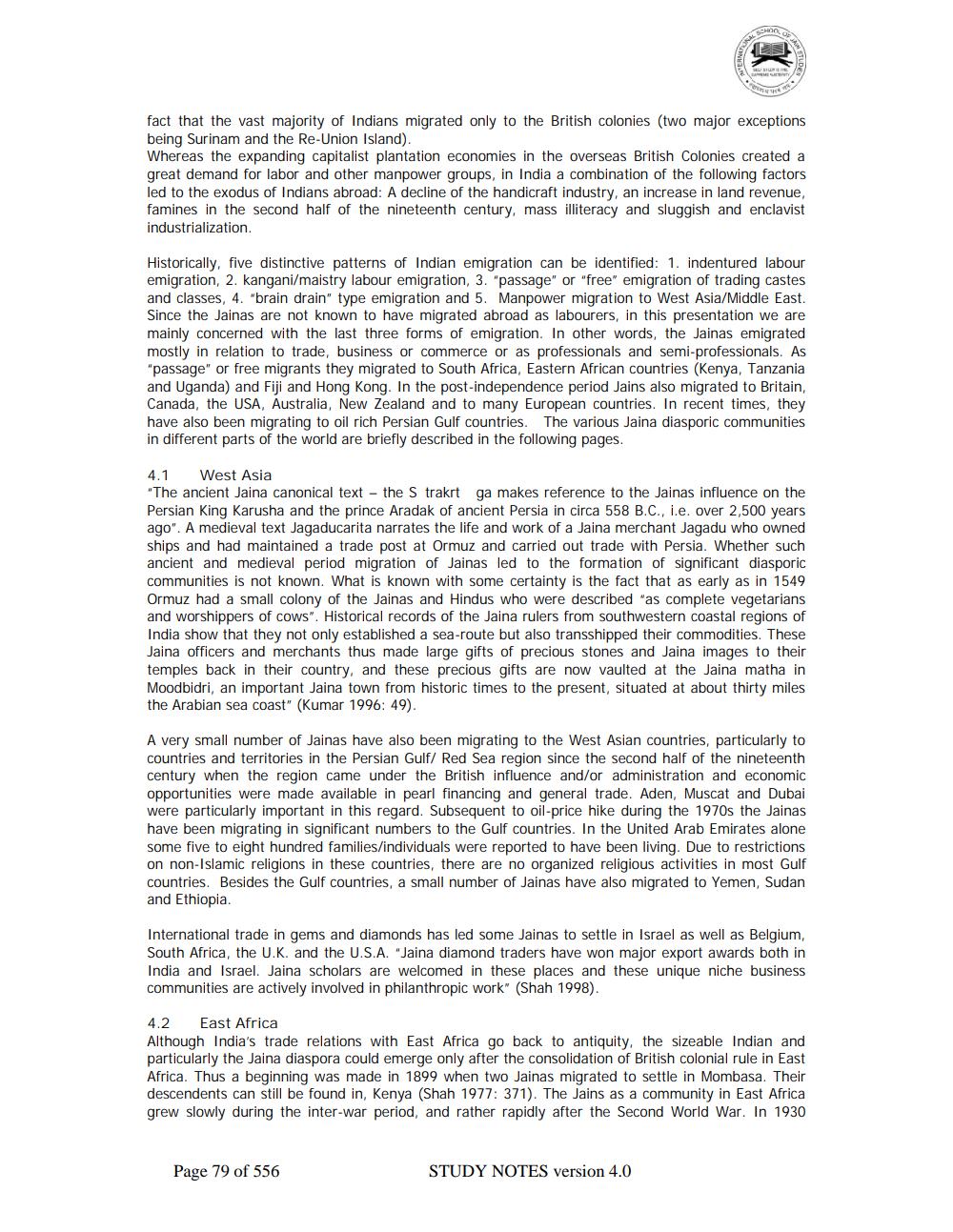________________
fact that the vast majority of Indians migrated only to the British colonies (two major exceptions being Surinam and the Re-Union Island). Whereas the expanding capitalist plantation economies in the overseas British Colonies created a great demand for labor and other manpower groups, in India a combination of the following factors led to the exodus of Indians abroad: A decline of the handicraft industry, an increase in land revenue, famines in the second half of the nineteenth century, mass illiteracy and sluggish and enclavist industrialization.
Historically, five distinctive patterns of Indian emigration can be identified: 1. indentured labour emigration, 2. kangani/maistry labour emigration, 3. "passage" or "free" emigration of trading castes and classes, 4. "brain drain" type emigration and 5. Manpower migration to West Asia/Middle East. Since the Jainas are not known to have migrated abroad as labourers, in this presentation we are mainly concerned with the last three forms of emigration. In other words, the Jainas emigrated mostly in relation to trade, business or commerce or as professionals and semi-professionals. As "passage" or free migrants they migrated to South Africa, Eastern African countries (Kenya, Tanzania and Uganda) and Fiji and Hong Kong. In the post-independence period Jains also migrated to Britain, Canada, the USA, Australia, New Zealand and to many European countries. In recent times, they have also been migrating to oil rich Persian Gulf countries. The various Jaina diasporic communities in different parts of the world are briefly described in the following pages.
4.1 West Asia "The ancient Jaina canonical text - the S trakrt ga makes reference to the Jainas influence on the Persian King Karusha and the prince Aradak of ancient Persia in circa 558 B.C., i.e. over 2,500 years ago". A medieval text Jagaducarita narrates the life and work of a Jaina merchant Jagadu who owned ships and had maintained a trade post at Ormuz and carried out trade with Persia. Whether such ancient and medieval period migration of Jainas led to the formation of significant diasporic communities is not known. What is known with some certainty is the fact that as early as in 1549 Ormuz had a small colony of the Jainas and Hindus who were described "as complete vegetarians and worshippers of cows". Historical records of the Jaina rulers from southwestern coastal regions of India show that they not only established a sea-route but also transshipped their commodities. These Jaina officers and merchants thus made large gifts of precious stones and Jaina images to their temples back in their country, and these precious gifts are now vaulted at the Jaina matha in Moodbidri, an important Jaina town from historic times to the present, situated at about thirty miles the Arabian sea coast" (Kumar 1996: 49).
A very small number of Jainas have also been migrating to the West Asian countries, particularly to countries and territories in the Persian Gulf/ Red Sea region since the second half of the nineteenth century when the region came under the British influence and/or administration and economic opportunities were made available in pearl financing and general trade. Aden, Muscat and Dubai were particularly important in this regard. Subsequent to oil-price hike during the 1970s the Jainas have been migrating in significant numbers to the Gulf countries. In the United Arab Emirates alone some five to eight hundred families/individuals were reported to have been living. Due to restrictions on non-Islamic religions in these countries, there are no organized religious activities in most Gulf countries. Besides the Gulf countries, a small number of Jainas have also migrated to Yemen, Sudan and Ethiopia.
International trade in gems and diamonds has led some Jainas to settle in Israel as well as Belgium, South Africa, the U.K. and the U.S.A. "Jaina diamond traders have won major export awards both in India and Israel. Jaina scholars are welcomed in these places and these unique niche business communities are actively involved in philanthropic work" (Shah 1998).
4.2 East Africa Although India's trade relations with East Africa go back to antiquity, the sizeable Indian and particularly the Jaina diaspora could emerge only after the consolidation of British colonial rule in East Africa. Thus a beginning was made in 1899 when two Jainas migrated to settle in Mombasa. Their descendents can still be found in, Kenya (Shah 1977: 371). The Jains as a community in East Africa grew slowly during the inter-war period, and rather rapidly after the Second World War. In 1930
Page 79 of 556
STUDY NOTES version 4.0




